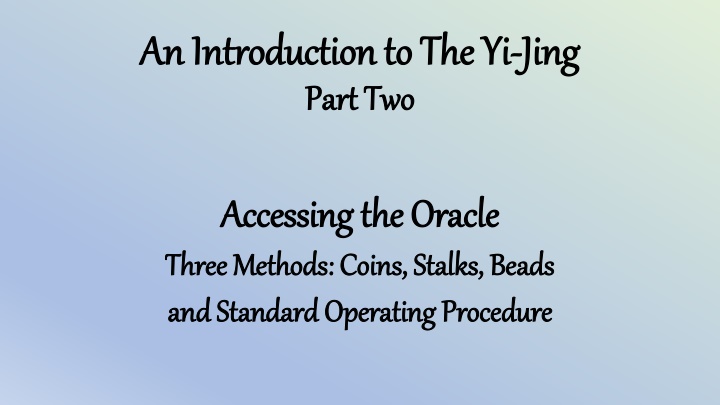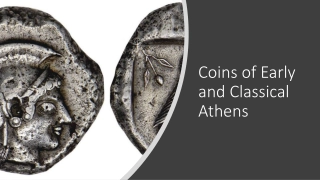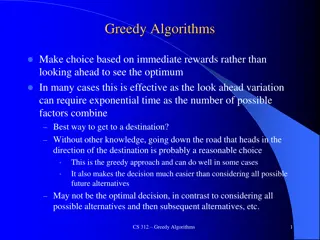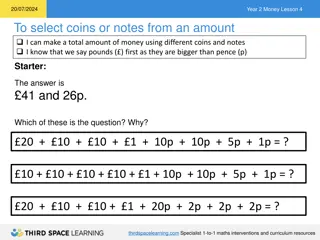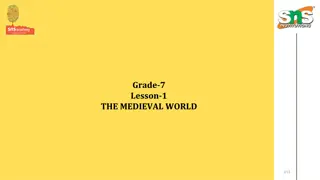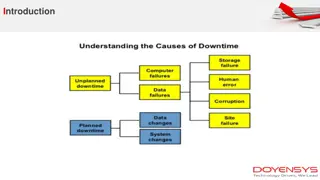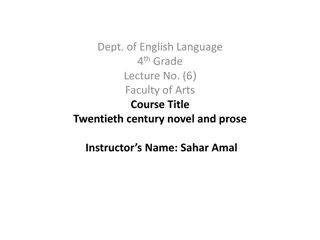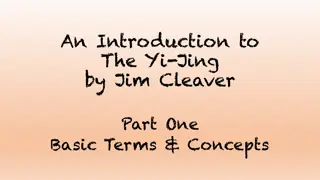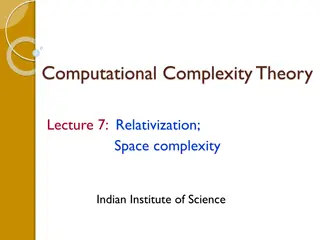Introduction to The Yi-Jing: Accessing the Oracle - Three Methods: Coins, Stalks, Beads
In this insightful guide, discover the ancient practice of accessing the oracle using three methods: Coins, Stalks, Beads. Learn the standard operating procedures and dive into the mystical realm of The Yi-Jing. Explore the wisdom and guidance this ancient divination tool offers.
Download Presentation

Please find below an Image/Link to download the presentation.
The content on the website is provided AS IS for your information and personal use only. It may not be sold, licensed, or shared on other websites without obtaining consent from the author.If you encounter any issues during the download, it is possible that the publisher has removed the file from their server.
You are allowed to download the files provided on this website for personal or commercial use, subject to the condition that they are used lawfully. All files are the property of their respective owners.
The content on the website is provided AS IS for your information and personal use only. It may not be sold, licensed, or shared on other websites without obtaining consent from the author.
E N D
Presentation Transcript
An Introduction to The Yi An Introduction to The Yi- -Jing Part Two Part Two Jing Accessing the Oracle Accessing the Oracle Three Methods: Coins, Stalks, Beads Three Methods: Coins, Stalks, Beads and Standard Operating Procedure and Standard Operating Procedure
Methods of Divination Many are possible, examples include: randomly open the book put lines, trigrams or hexagrams in a hat or bowl, shuffle and pick one out ask an uninvolved person to pick a number between one and sixty-four Two traditional methods 1. Stalk Method: Shang/Zhou Dynasty ~1500 1100 BCE, but the earliest account is from the Great Commentary c. 100 BCE 2. Coin Method: attributed to Wang Xi ~4th century BCE, soon after coinage was invented coins seem to have replaced stalks as a standard method during the Tang dynasty.
The Coin Method The Coin Method Three coins are used (Determine which side will be yang & which will be yin, before you begin) 1. With your question clearly in mind shake the coins and drop them onto a level surface. 2. Examine the number of heads & tails } there are 4 possible combinations. 3 heads 3 tails 2 heads & 1 tail 2 tails & 1 head 3. Assign a number value to the yin & yang sides of the coins and add them together. Heads = 3 Tails = 2 there are 4 possible totals 9, 8, 7, 6 4. Translate the 6, 7, 8, 9 into the appropriate line as follows: (you can save this step until the divination process is finished if you like)
Shortcut Shortcut(memorize instead of adding) 3 Heads = 9 (3+3+3) = o a moving/changing yang line 3 Tails = 6 (2+2+2) = x a moving/changing yin line 2 Heads (1T) = 8 (3+3+2) = a non-moving/stable yin line 2 Tails (1H) = 7 (2+2+3) = a non-moving/stable yang line 6 and 9 are relatively extreme and therefore unstable and changing, or moving 7 and 8 lie between the two extremes and are therefore stable or unchanging
Coin Method (Continued) Coin Method (Continued) Repeat this process 5 more times (6x altogether), once for each line of the hexagram. Build your hexagram from the bottom to the top, i.e. the bottom is line is the first line. Changing lines (6 & 9): are 3x less likely than stable lines (7 & 8) Probability suggests you will get 2 lines changing in a typical cast hexagram, but you could get any number from 0 to 6 (7 possibilities).
Lets Take a Look at where we are You now have a stack of 6 lines - i.e. a hexagram This hexagram is known as the = a root, the root; the foundation, base, the origin(al), initial hexagram Notice: you have two basic types of lines: solid lines are designated as yang lines divided lines are designated as yin lines Notice now that you have two types of yang lines 7 s & 9 s 7 s are stable yang lines, 9 s are changing yang lines (the graphic helps here) You also have two types of yin lines 8 s & 6 s 8 s are stable yin lines, 6 s are changing yin lines Note: yin are even numbers, while yang are odd (this is a basic yin/yang correlation) b n gu
Your Next Step Requires a Book Somewhere obvious your book should have a KEY The KEY is usually a square with all 8 trigrams arrayed along both the vertical and horizontal axis Step 1: divide your hexagram in half (between lines 3 & 4) so you can separate it into two Trigrams Identify the Upper and Lower Trigram that comprise your hexagram The nature of the lines - stable or changing - are not relevant here Only the Yin/Yang nature is important Step 2: Using the KEY find the intersection where the column for your Upper trigram and row for your Lower meet It will be a number from 1-64 This is your Ben Gua or Initial Hexagram
Hexagram Name and Number You can now thumb through your book to the number indicated and read the oracle s response to your question. These are in order 1-64, so once you ve identified its number it s easy. Each hexagram has a Name - this is how it is known and referred to, though it may seem rather cryptic. It also depends on how your author chose to translate it there are multiple possibilities. But names are important, so a good translator is also critical to your understanding. But you also have to remain flexible here, as no single word is going to suffice for all instances. By the way most names are just one character but a few are two. At this point you have a #, a name and component trigrams Numbers are fixed and constant, but names are not. The trigrams are also fixed, but realize that there are two hexagrams with the same two trigrams within it but only one has the specific configuration of upper and lower that you just got so each of the 64 is indeed unique and has a different name and number. But it will have a relative with the trigrams reversed. 64 is the mathematically complete number of possible combinations.
Start Reading But what to Read Typically the first part of the text is known as The Judgement , sometimes it is called The Decision . Sometimes there is no label. Following that are often some comments/explanations by your author. Next is sometimes called the Image or Symbol text. This discusses the component trigrams in your hexagram. You can read everything up to what will designated as The Lines or Line Texts . There will be six of these (except the first two hexagrams usually have a seventh). You will only read Line texts for those lines which were changing, however many there were. If there were none you are done with this part. Spend time reading and thinking about what is being said in light of you question.
Stage 2 Change your Changing Lines to form a New Hexagram In terms of Yin & Yang, Change will always be mean into its opposite. Thus a 6 (changing yin) will turn into a stable yang line (7) and a 9 (changing yang) will turn into a stable yin line (8). Once you have done this you have a new hexagram. This one is called zh gu I call this the Resultant Hexagram. Change all your moving lines and divide into component trigrams as before. Go to your KEY and look up the new number. Find your New/Resultant hexagram in your book and read everything except this time no lines are changing so that part is only relevant in the first hexagram.
Finishing Up Thus your complete reading (response to your Question) usually results in two hexagrams, with one or more line text to read in the Initial Hexagram (Ben Gua). If you happen to receive no moving lines, then that hexagram name and basic texts is the total reading. That said, I sometimes think it useful to read all the line texts, even though none are being highlighted as relevant on this occasion. This is the basic procedure no matter what method you are using. Next we will go through the more traditional (and complicated) Stalk Method. Trust me there is a reason to learn it too.
Lets Give it a Try Coins = # = Line type = Trigram = Hexagram & Name Drop 6: Drop 5: Drop 4: 3H+0T = 9 2H+1T = 8 2H+1T = 8 = 0 = = = Gen (upper trigram) } = 27 Yi / Nourish Drop 3: Drop 2: Drop 1: 2H+1T = 8 2H+1T = 8 2T+1H = 7 = = = = Zhen (lower trigram) Read: Texts for H:27 + text for changing line = L:6/top line (27.6)
Procedure continued: Procedure continued: Calculating the Resultant Hexagram Calculating the Resultant Hexagram Initial Hexagram (Ben Gua) Resultant Hexagram (Zhi Gua) 0 upper trigram = Gen upper trigram = Qian } = 27 Yi / Nourishment } = 24 Fu / Return = Zhen lower trigram = Zhen lower trigram Read: Texts for H:24 there are no changing lines to read this time
Stalks Stalks (you will need 50 stalks 6 to 12inches long), usually yarrow (Achillea usually yarrow (Achillea milfolium milfolium) is used, but sometimes bamboo you could use chopsticks or stick matches for that matter you could use chopsticks or stick matches for that matter Spend time to formulate your Question write it down date it then with your question clearly in mind, begin your divination process Step 1: remove one stalk and set it aside (it will not be used for the rest of the process think of it as holding the space It represents the Dao) Step 2: [Holding your question in mind] randomly divide the 49 remaining stalks into two bundles (one in each hand) Step 3: Remove one stalk from the Right hand bundle (stick it in a glass) Step 4: Remove stalks 4 at a time from the Left hand bundle until you have four or fewer remaining (put these in the glass) Step 5: Remove stalks 4 at a time from the Right hand bundle until you have four or less (and put these in the glass too there should be either 5 or 9 in the glass) ) is used, but sometimes bamboo
Stalk Method (continued) Stalk Method (continued) Step 6: Gather all the stalks from the L & R bundles (groups of 4) back together i.e. everything except the ones in the glass (and the first one) they are all out of play now Step 7: Repeat steps 2 thru 5 put the leftover stalks in the glass (there should be either 4 or 8 stalks this time) they too are now out of play Step 8: Repeat steps 2 thru 5 again (3rdtime) put the leftover stalks in the glass (there will be either 4 or 8 stalks again), but most importantly in this round leave all the little bundles of 4 you counted out in distinct groups of four. Step 9: Count the bundles of four there should be 6-7-8 or 9 bundles. Recognize those numbers? They tell you what kind of line you divined: just like we did with the coins. This is the first/bottom line of your hexagram. Now gather all 49 stalks back together and repeat Steps 1-9 to discover line 2. Repeat this process 4 more times to build your hexagram. It takes 18 divisions altogether.
Line Probability Ratios Line Probability Ratios Remember the ratio of stable to changing lines with the coins was 3 to 1, thus we arrived at the probability of obtaining 2 changing lines in any given hexagram. Moreover the probability of a 6 or a 9 is the same, and likewise 7 & 8 are equivalent, albeit 3x more than 6 or 9. With the stalk method those probabilities are slightly different with each type of line having a unique probability ratio compared to each other.
Probability Ratios (continued) Probability Ratios (continued) Let s recall: Ratio = 3/16 Chance = 19% 9 = o a moving/changing yang line 6 = x a moving/changing yin line = 1/16 = 6% 8 = a non-moving/stable yin line = 7/16 = 41% 7 = a non-moving/stable yang line = 5/16 = 31%
Probability Ratios (continued) Probability Ratios (continued) Overall, the ratio of yin to yang lines is 50/50 or 1:1 in both methods Overall, the ratio of stable to changing lines is 75/25 or 3:1 in both methods But the particulars are unique to each line using the stalk method and better reflects the fundamental nature of reality. So coins sacrifice accuracy/specificity for the sake of simplicity
Probability Ratios (continued) Probability Ratios (continued) Yin lines (8 & 6) Stable yin lines are the most probable/common, while changing yin are the least probable. In other words yin is more stable and less likely to change, which is in keeping with its quiescent nature. Yang lines (7 & 9) Yang is less frequent as a stable line, and more frequent as a moving line. In other words yang is more active and therefore more changeable, which is in keeping with its dynamic character.
Probability Ratios (continued) Probability Ratios (continued) Although there is no difference between the two systems in terms of the overall probability of receiving a given Initial Hexagram. There is a difference in the likelihood of a given hexagram changing into a specific hexagram (i.e. Resultant Hex. probability), since you are three times more likely to get a changing yang line (9) than a changing yin line (6).
The Bead Method The Bead Method Combining the Accuracy of the Stalks with the Simplicity of the Coins Combining the Accuracy of the Stalks with the Simplicity of the Coins What you need: 16 Beads or marbles in four different colors, but otherwise the same size, shape and weight. The four colors will be unequal in the same ratios as the stalks i.e. 1-3-5-7. 7 beads of color A 5 beads of color B 3 beads of color C 1 bead of color D
The Bead Method (continued) The Bead Method (continued) You also need a smallish, flexible (cloth or leather) pouch It should also be opaque. Put the 16 beads in the bag and squish them around to mix them up Then with your Question in mind as always, reach in and retrieve a bead. Pull it out notice its color and return it to the pouch. The color of the bead = the nature of the line just like the coins & stalks. Color A = 8 Color B = 7 You can write down the color or the Divination # (6-7-8-9), or draw the line Color C = 9 0 Color D = 6 X
The Bead Method (continued) The Bead Method (continued) Repeat this 5 more times to construct your Initial Hexagram. I recommend memorizing your colors to match the Divination # and simply record that number, then go back when you are done and draw the lines to create your hexagram graph. That way you can keep your focus on your question and the process of drawing out beads to its simplest. Once you have your hexagram drawn, figure out the component trigrams, turn to your KEY and find your hexagram #, read the relevant texts, then convert all the changing lines to create your Resultant Hexagram and continue reading.
Interpreting Your Results Interpreting Your Results All the while you are contemplating what your are reading in terms of the question you asked and trying to understand the response the Yi has provided. Generally the clearer your Q , the clearer is the response, i.e. the more it makes sense. Your task now is to try your best to implement the advice received and insight gained. This of course plays out over time, so keep your thoughts attuned to the reading as well as the process to see how it all actually plays out.
